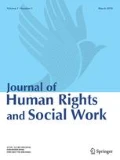Abstract
This paper presents a model for the function of specialized vocabulary schemes in the development, implementation, and dissemination of trauma rehabilitation initiatives. With 65.3 million forcibly displaced people worldwide, of whom 21.3 million are recognized refugees (UNHCR 2016), understanding trauma rehabilitation is timely. This paper takes an interest in the effects of interventions that leverage specialized vocabulary schemes to assist victims of conflict to overcome psychosocial trauma. Lessons are taken from three research studies conducted in conflict and post-conflict environments, which are discussed in the context of literature that demonstrates how vocabulary development is critical to psychosocial rehabilitation. From a review of these studies, a model of the function of specialized vocabulary schemes in the development, implementation, and dissemination of trauma rehabilitation initiatives is presented. Rehabilitation using one's own language is key to the restoration of human rights after ongoing psychological torture as it provides a means for categorizing experiences and developing understandings.

Similar content being viewed by others
References
Ahola, A., & Kovacik, A. (2007). Observing and understanding child development: A child study manual. New York: Thomson Delmar Learning.
Ardila, A., Bernal, B., & Roselli, M. (2016). How localized are language brain areas? A review of Brodmann areas involved in oral language. Archives of Clinical Neuropsychology, 31(1), 112–122.
Baddeley, A. (1993). A theory of rehabilitation without a model of learning is a vehicle without an engine: A comment on Caramazza and Hillis. Neuropsychological Rehabiliation, 3(3), 235–244.
Bandura, A. (1986). Social foundations of thought and action: A social cognitive theory. Englewood Cliffs: Prentice Hall.
Bandura, A. (2001). Social cognitive theory: An agentic perspective. Annual Review of Psychology, 52, 1–26.
Bronfenbrenner, U. (1979). The ecology of human development: Experiments by nature and design. Cambridge: Harvard University Press.
Bolton, P., Bass, J., Betancourt, T., Speelman, L., Onyango, G., Clougherty, K. F., Neugebauer, R., Murray, L., & Verdeli, H. (2007). Interventions for depression symptoms among adolescent survivors of war and displacement in northern Uganda. Journal of the American Medical Association, 298, 519–527.
Bolton, P. (2001). Cross-cultural validity and reliability testing of a standard psychiatric assessment instrument without a gold standard. Journal of Nervous and Mental Disease, 189(4), 238–242.
Eliot, L. (2000). What’s going on in there? How the brain and mind develop in the first five years of life. New York: Bantam Books.
Feuerstein, R., Feuerstein, R. S., & Falik, L. H. (2010). Beyond smarter: Mediated learning and the brain’s capacity for change. New York: Teachers College Press Columbia University.
Gandour, J., Tong, Y., Wong, D., Talavage, T., Dzemidzic, M., Xu, Y., Li, X., & Lowe, M. (2004). Hemispheric roles in the perception of speech prosody. NeuroImage, 23(1), 344–357.
Hari, R., & Kujala, M. V. (2009). Brain basis of human social interaction: From concepts to brain imaging. Physiological Reviews, 89(2), 453–479.
Honwana, A. (2011). Child soldiers in Africa. Philadelphia: University of Pennsylvania Press.
Kuhl, P. K. (2010). Brain mechanisms in early language acquisition. Neuron, 67(5), 713–727.
Lave, J., & Wenger, E. (1991). Situated learning: Legitimate peripheral participation. New York: Cambridge University Press.
Marton, F., & Booth, S. (1997). Learning and awareness. Mahwah: Lawrence Erlbaum Associates Publishers.
McMullen, J. D., O’Callaghan, P. S., Richards, J. A., Eakin, J. G., & Rafferty, H. (2012). Screening for traumatic exposure and psychological distress among war-affected adolescents in post-conflict northern Uganda. Social Psychiatry and Psychiatric Epidemiology, 47(9), 1489–1498.
Nagel, M. C. (2012). In the beginning: The brain, early development and learning. Camberwell: Australian Council for Educational Research.
Pinker, S. (2007). The language instinct: How the mind creates language. New York: Harper Perennial Modern Classics.
Pulvermuller, F. (2005). Brain mechanisms linking language and action. Nature Reviews Neuroscience, 6(7), 576–582.
Sonderegger, R., Rombouts, S., Ocen, B. C., & McKeever, R. S. (2011). Trauma rehabiliation for war-affected persons in northern Uganda: A pilot evaluation of the EMPOWER program. British Journal of Clinical Psychology, 50(3), 234–249.
Tol, W. A., Song, S., & Jordans, M. J. D. (2013). Annual research review: Resilience and mental health in children and adolescents living in areas of armed conflict—A systematic review of findings in low- and middle-income countries. The Journal of Child Psychology and Psychiatry, 54(4), 445–460.
UNHCR. (2016). Global trends: Forced displacement in 2015. Geneva: United Nations High Commission for Refugees.
United Nations. (1948). The Universal Declaration of Human Rights. General Assembly resolution 217A. Paris: Author.
Vialle, W., Lysaght, P., & Verenikina, I. (2005). Psychology for educators. Southbank: Thomson Social Science Press.
Vygotsky, L.S. (1978). Mind in society: The development of higher psychological processes. (M. Cole, Trans.). Cambridge: Harvard University Press.
Vygotsky, L.S. (1986). Thought and language. (A. Kozulin, Trans.). Cambridge: MIT Press.
Willis, A.S. (2012). Teachers’ conceptions of children’s learning in Northern Uganda: a phenomenographic study in a post war context. Doctoral Thesis. http://research.usc.edu.au/vital/access/manager/Repository/usc:8999.
Willis, A. S., & Nagel, M. C. (2015). The role that teachers play in overcoming the effects of stress and trauma on children’s social psychological development: Evidence from Northern Uganda. Social Psychology of Education, 18(1), 37–54.
Author information
Authors and Affiliations
Corresponding author
Rights and permissions
About this article
Cite this article
Willis, A.S., Nagel, M.C. The Function of Specialized Vocabulary Development in Psychosocial Rehabilitation in Traumatized Populations. J. Hum. Rights Soc. Work 3, 29–34 (2018). https://doi.org/10.1007/s41134-017-0046-z
Published:
Issue Date:
DOI: https://doi.org/10.1007/s41134-017-0046-z




